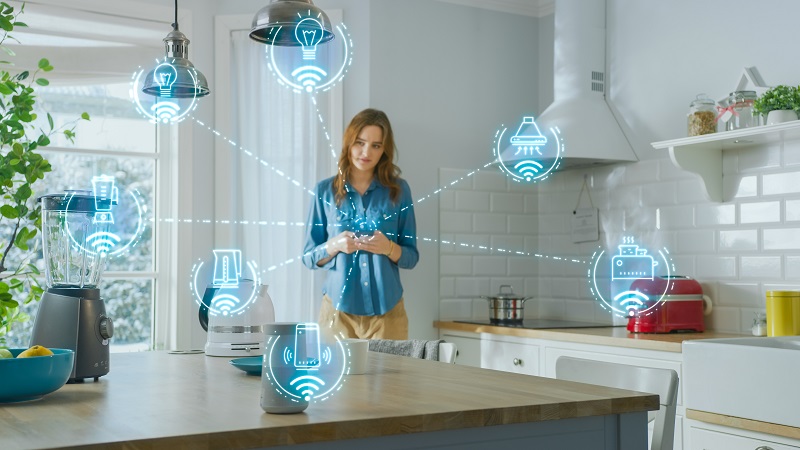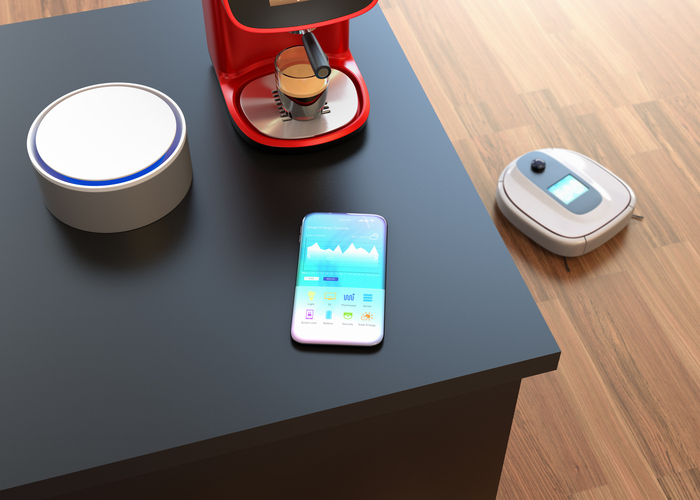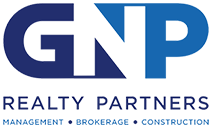
Just 20 years ago, people with cell phones or other mobile devices had them primarily for business purposes. Now, it’s hard to find someone without a phone, tablet, or laptop and the technology is quickly becoming more and more apparent in our houses and apartments.
A 2021 survey conducted by Houzz shows a rise in the number of smart home renovation projects, with 19% of homeowners who have completed a renovation project in the previous year reporting they added smart home technology to their homes. This could range anywhere from voice-activated lights to surveillance equipment or wireless speakers. People like using their voice, mobile device or tablet to turn off lights when they aren’t home.
Homeowners are embracing the world of smart technology since most of it allows for voice control. It’s easy to walk into a home and say, “Alexa, turn on my lights,” instead of fumbling for your cell phone light after digging around in your bag. According to Statistica, the global voice recognition tech market reached nearly $10 billion in 2020 and is projected to reach close to $30 billion in 2026.
Below we detail some of the latest smart-home innovations, their benefits and how they are transforming residential living.
Want to learn more about Smart Home Integrations?
Request Information | or Call Us at 312-329-8400
Prioritizing Safety & Security FIRST!
Your home should be your castle — and the latest home gadgets can help it stay that way. Home security innovations such as Wi-Fi-powered security cameras have lowered the price point for residential safety, allowing more homeowners to effectively and inconspicuously safeguard their property. In addition to minimizing or eliminating the need to drill holes, affix concrete anchors, and run lines, such systems stream video directly to users’ preferred mobile devices.
However, these are far from the only developments in residential security. Doorbells with embedded cameras offer an ongoing visual feed that lets you know who is at your front door and provides a legal record of any criminal activity. Older systems protected windows with fragile wired screens or used motion-detecting cameras prone to false alarms. Wireless window alarms eliminate the need for this older, cumbersome home technology.
Finally, wireless driveway alarms provide alerts before an interloper tries to access a home. And homeowners never need to worry about forgetting to lock their doors when they leave. Smart locks allow you to bolt your door from anywhere via phone. (Read more about the benefits of always-on connectivity below.)
Staying Connected at All Times

Busy people can struggle to remember or plan for the most essential tasks. The previous smart lock reference is a good example, but have you ever forgotten to turn off your oven, adjust your thermostat, turn on your alarm or set the coffee maker to brew? With a fully connected home, you won’t have to worry about that again. Dubbed the “Internet of Things,” multiple smart appliances take the trials out of common tasks. Thanks to in-home interconnectivity, you can start your dishwasher, turn on or off the clothes dryer, and start your robotic vacuum cleaner. The best part? Some devices will communicate with each other and on the same software platform.
Constant connectivity offers additional advantages. For instance, residents can often set up contingent actions through interconnected appliances and devices. Want to listen to music when a stove timer goes off? How about automatically raising the temperature when you leave for the day? Fancy a coffee after a certain amount of computer time? An interconnected home can do all that. Moreover, remaining online means dedicated technicians can quickly diagnose errors before sending personnel to your property.
Improving Communication (In-House Calls and Alerts)
The previously mentioned security innovations that help protect homes from thefts and break-ins, also support better communications. App-based and cloud functionality makes them accessible from any device with a web browser. Instead of waiting for a phone call when an alarm gets tripped, you receive an instant message on your smartphone. And many smart homes can tell you if they detect a water leak or the presence of smoke.
Improved communication extends beyond security systems. Smart home technology can help you find lost items you tag with coded transmitters. It also allows you to communicate with various home systems and vice versa, no matter where you are. When your furnace, air conditioner, and multiple appliances can “talk” with you about their settings, you have more than an energy-efficient home. You also have an incredibly convenient one.
The Benefits of Smart Technologies
Remote Monitoring & Check-Ins
The ability to remotely monitor and check on your home is an essential component of a smart home ecosystem. Smart homes equipped with remote monitoring allow homeowners to keep a watchful eye on their property and loved ones from afar. Such technology allows you to monitor security and doorbell cameras, motion sensors, and other devices designed to detect potential threats. This ability to keep an eye on things when you’re away provides much-needed peace of mind.
Customized Preferences & Settings
Smart technologies provide homeowners with convenience and customization when controlling their environment. Customized preferences and settings are one of the key benefits of a smart home ecosystem. Following are examples of how you can customize your smart home to meet your specific needs and preferences:
- Lighting: Customize the lighting in your home by setting up different scenes for different times of the day or activities. For example, you can create a “movie night” setting that dims the lights and turns on your entertainment system with a single voice command.
- Temperature: Customize the temperature in your home by setting up different zones and scheduling them to change throughout the day. For example, you can program your bedroom to be cooler at night and warmer in the morning.
- Audio and Entertainment: Customize your audio and entertainment experience by setting up different speakers and sound systems for different areas of your home. For example, you can have a dedicated home theater system in your living room and separate music speakers in your bedroom.
- Voice Commands: Customize your voice commands by creating custom routines that trigger multiple actions with a single command. For example, you can create a “goodnight” routine that turns off all your lights, sets your alarm and adjusts your thermostat to your preferred sleeping temperature.
Energy & Utilities Management
A smart home ecosystem can help users save money and reduce their environmental impact by providing energy and utilities management features. Users can lower their bills and reduce their carbon footprint by optimizing energy and water usage. Here are some examples:
- Smart Thermostats: Smart thermostats learn users’ daily routines and adjust the temperature to optimize energy usage. They can also be controlled remotely, allowing users to adjust the temperature when away from home.
- Smart Lighting: Smart lighting can be controlled remotely and scheduled to turn on and off at specific times to reduce energy usage. Some smart lighting systems will also adjust the intensity and color of the lights to match users’ preferences and activities.
- Energy Monitoring: Smart home devices monitor energy usage, such as electricity consumption, and provide insights into usage patterns and cost. This can help users identify opportunities to reduce energy consumption and save money.
- Smart Appliances: Smart appliances, such as refrigerators, ovens and washing machines, can be controlled remotely and programmed to run during off-peak hours when energy prices are lower.
- Water Management: Smart home devices monitor water usage, such as shower time and toilet flushes, and provide insights into usage patterns and cost. This can help users identify and target areas to reduce water consumption and save money.
Endless Customization Possibilities to Every Aspect of Your Home
Like people, houses differ greatly—even ones similar in design and size. For instance, a property’s location on a specific plot might cause interior microclimates that shift throughout the day. Different individuals’ schedules could put varying energy demands on a residence. And owners’ varying habits might lead one to want to listen to classical music while doing the dishes and another to have late-night television on while exercising in a workout room.
A smart home accommodates all of these desires from a smartphone with ease and convenience. Program your thermostats to account for temperature fluctuations or adjust them whenever (and wherever) you want. Set lights to turn on, dim or off depending on your schedule. Let web-enabled virtual assistants provide you with productivity-enhancing programming or prearranged entertainment. The sky truly is the limit when it comes to smart home technology.
GNP Realty’s in-house family of diversified companies provides our clients with full-service strategy and hands-on support for all your real estate needs. From brokerage and management to construction and maintenance, we tailor our commercial and residential services to help you achieve your goals as a property owner or investor.








